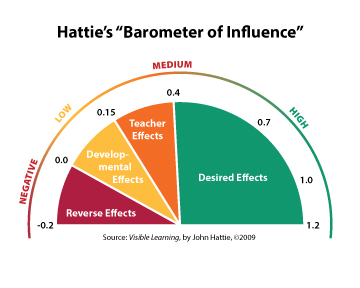Leveraging ‘The Big 5 of Reading’ in the Elementary Classroom—Part 1
Editor’s Note: Today’s blog is Part 1 of 2 discussing “The Big 5 of Reading” components and instruction, including:
- Phonemic Awareness
- Phonics/Advanced Word Study
- Fluency
- Vocabulary
- Comprehension
Read today’s blog to learn more about phonemic awareness and phonics/advanced word study.
Check out Part 2 focusing on fluency, vocabulary, and comprehension.
Think of your favorite TV series. Have you routinely watched an episode from that series, even though you already know exactly how it ends? Perish the thought that someone interrupts you while you’re watching that very episode for the 100th time.
Adults and children thrive on predictability. We enjoy things that are familiar. Establishing predictable routines that are not only research based but also research validated will lend to a sense of calm within our classrooms.
To begin, we need to know what research is telling us. Let’s look at John Hattie’s work, it gives us quantifiable insights. The weight of more than 800 meta-analyses related to achievement, based on more than 50,000 studies involving millions of students, gives us needed insight.
An effect size of 0.40 is what Hattie refers to as a hinge point regarding what is significantly effective or at “a level where the effects of innovation enhance achievement in such a way that we can notice real-world differences” (Hattie, 2009)1. Anything between a 0.00 and 0.39 is growth, but is not considered significant growth. Anything below a 0.00 is considered detrimental to student growth.

“The effect size of direct instruction curriculum is high at .59” (Fisher, Frey, Hattie, 2016)2.
Their research goes on to find that “the features of direct instruction apply more broadly and include key elements of the lesson design:”
- The teacher should plan according to the learning intentions. Student engagement and commitment is built through discussion of the learning intentions, success criteria, and tasks
- The teacher presents the lesson using modeling and frequent checks for understanding
- Guided instruction occurs such that the teacher is able to provide scaffolds and feedback to move the student toward independence
- The teacher knows the success criteria and utilizes results to analyze the impact of teaching on student learning
- Closure of the direct instruction portion of the lesson occurs such that students revisit the learning intentions and success criteria, as well as the key learning points
- Independent learning continues as students apply newly learned knowledge to new, but parallel, situations
When evaluating materials to use in your classroom, how do they stand up to this list?
Ask yourself:
- Do the program or strategies I’m using include explicit, systematic instruction in each of the critical reading components—phonemic awareness, phonics/advanced word study, fluency, vocabulary, and comprehension?
- How do I leverage the power of “The Big 5” while maximizing the effectiveness of direct instruction?
Let’s look at how it can be done.
Phonemic Awareness
Phonemic awareness is presented logically and systematically, with specific instructions for explicit teaching. Students learn to manipulate individual sounds in words in a carefully sequenced series of lessons. Students count, identify, or isolate phonemes, learning to isolate beginning, middle, and ending sounds in words. This prepares students for the key skills of segmenting and blending words and sounds (e.g., Stretch and Slide activities). As students gain facility with manipulating sounds orally, print is integrated with the phonemic awareness activities (e.g., Stretch and Slide with Letters). Students are taught the critical elements of segmenting and blending sounds orally and then they are able to master the skill of matching sounds to letters. These critical phonemic awareness skills are well integrated within each lesson so students learn to segment and blend the sounds of language, match sounds to letters, and have ample time to practice and demonstrate their learning. Additionally, these integrated activities transition to phonics and spelling activities so students can apply what they have mastered in phonemic awareness.
Phonics/Advanced Word Study
Utilizes the extensive research base in phonics to develop systematic and explicit phonics and spelling lessons beginning in kindergarten. This provides numerous opportunities for practice reading and spelling both phonemically regular and irregular words.
Students receive immediate practice applying newly learned phonics skills in text. The text has been carefully constructed to correspond with the phonics skills students are learning while engaging them in interesting topics. The frequent application of phonics to both reading and the reciprocal skill of spelling strengthen the knowledge students have about the sound-symbol system.
Check out Part 2 of Leveraging ‘The Big 5 of Reading’ in the Elementary Classroom.
Interested in learning more about John Hattie and his latest book, “Visible Learning for Literacy?” Register now for our EDVIEW 360 webinar, podcast, and blog series and be one of the first to listen to this special podcast on January 21.
References
1. (Hattie, 2009)
2. (Fisher, Frey, & Hattie, 2016)


